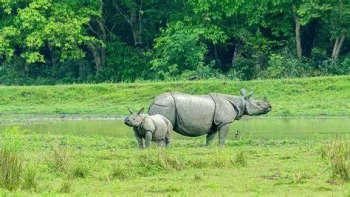National Museum of China Travel Guide
The National Museum of China, located in Beijing, is one of the largest and most comprehensive museums in the world. It showcases China's rich history, art, and culture, spanning over 5,000 years. The museum's collection includes ancient artifacts, traditional costumes, calligraphy, and contemporary art, offering visitors a fascinating insight into the country's heritage. With its impressive architecture and educational exhibitions, the National Museum of China is a must-visit for history buffs and art enthusiasts alike.Top Attractions in National Museum of China
- Exhibition Halls showcasing Chinese history
- Ancient artifacts and cultural relics
- Art galleries featuring traditional and contemporary artworks
National Museum of China is Famous for
Its extensive collection of artifacts and artworks that represent China's rich cultural heritage.Top Attractions in National Museum of China
- Explore the Hall of Ancient Chinese Bronze
- Admire the Ming and Qing Dynasty furniture collection
- Attend calligraphy and painting exhibitions
What's Great about Travelling to National Museum of China?
- History enthusiasts will be captivated by the museum's exhibitions
- Art lovers can admire a diverse range of traditional and contemporary artworks
- Visitors can gain a deeper understanding of China's cultural heritage
What's Not So Great about Travelling to National Museum of China?
- Those not interested in history or art may find the museum less engaging
- Visitors with limited time may not be able to explore the vast collection thoroughly
Travel Tips for National Museum of China
- Check the museum's website for current exhibitions and events
- Avoid peak hours to enjoy a more relaxed visit
- Respect the museum's rules and regulations, such as no photography in certain areas
Important National Museum of China trip information
- Ideal Duration: Plan for at least half a day to explore the museum thoroughly
- Best Time to Visit: Weekdays are less crowded than weekends
- Nearby Airports and Railway Stations: Beijing Capital International Airport, Beijing Railway Station
Per Person
3,00,000
*EXCLUDING APPLICABLE TAXES 5.0 Ratings
( 57 Reviews )
( 57 Reviews )
Per Person
40,000
*EXCLUDING APPLICABLE TAXES Per Person
34,990
*EXCLUDING APPLICABLE TAXES Per Person
16,500
*EXCLUDING APPLICABLE TAXES 5.0 Ratings
( 9 Reviews )
( 9 Reviews )
Per Person
18,000
*EXCLUDING APPLICABLE TAXES Per Person
15,000
*EXCLUDING APPLICABLE TAXES FAQ's on National Museum of China
Q1: What is the best time to visit National Museum of China?
The best time to visit the National Museum of China is during the spring (March to May) and autumn (September to November) when the weather is pleasant, and tourist crowds are manageable. These seasons offer comfortable temperatures for exploring the museum and enjoying outdoor attractions in Beijing.
Q2: Do I need a visa to travel to National Museum of China?
Most visitors to China will need a visa to travel to the National Museum of China. It is recommended to check with the Chinese embassy or consulate in your country for specific visa requirements. Some nationalities may be eligible for visa exemptions or visa-on-arrival options for short visits.
Q3: What are the must-visit attractions in National Museum of China?
The National Museum of China is a must-visit attraction in Beijing, offering a comprehensive collection of Chinese art and history. Other top attractions in the city include the Great Wall of China, Forbidden City, Temple of Heaven, and Summer Palace, all showcasing the rich cultural heritage of China.
Q4: Is National Museum of China a safe place to travel?
National Museum of China and Beijing, in general, are safe places to travel. It is advisable to exercise usual precautions, such as safeguarding personal belongings in crowded areas and being aware of your surroundings. Avoiding isolated areas at night is recommended, and following local laws and regulations is important for a safe trip.
Q5: What is the local currency in National Museum of China and can I use credit cards?
The local currency in China is the Chinese Yuan (CNY). ATMs are widely available in Beijing, and major credit cards are accepted at hotels, restaurants, and larger stores. However, it is advisable to carry cash for smaller purchases and when visiting local markets or street vendors.
Q6: What is the local cuisine like in National Museum of China?
Chinese cuisine is diverse and flavorful, with popular dishes like Peking duck, dumplings, hot pot, and Beijing noodles. Visitors to the National Museum of China can explore traditional Chinese tea houses and street food stalls for authentic culinary experiences. Vegetarian and halal food options are also available in Beijing.
Q7: What transportation options are available in National Museum of China?
Transportation options in Beijing include an efficient subway system, buses, taxis, and ride-sharing services like Didi. Visitors can also consider renting bicycles to explore the city at their own pace. It is recommended to use official taxis with meters or reputable car services for transportation.
Q8: Are there any cultural norms or etiquette I should be aware of when visiting National Museum of China?
When visiting the National Museum of China and other cultural sites in Beijing, it is important to show respect by dressing modestly and following local customs. Avoid public displays of affection, be mindful of photographing locals without permission, and learn basic Chinese greetings for interactions with residents.
Q9: I am a travel agent. How can I buy travel leads of National Museum of China?
Register yourself as a travel agent at agents.tripclap.com and then you can buy travel leads to National Museum of China once your account is approved. For more details contact our support team at +91-8069186564 or support@tripclap.com






